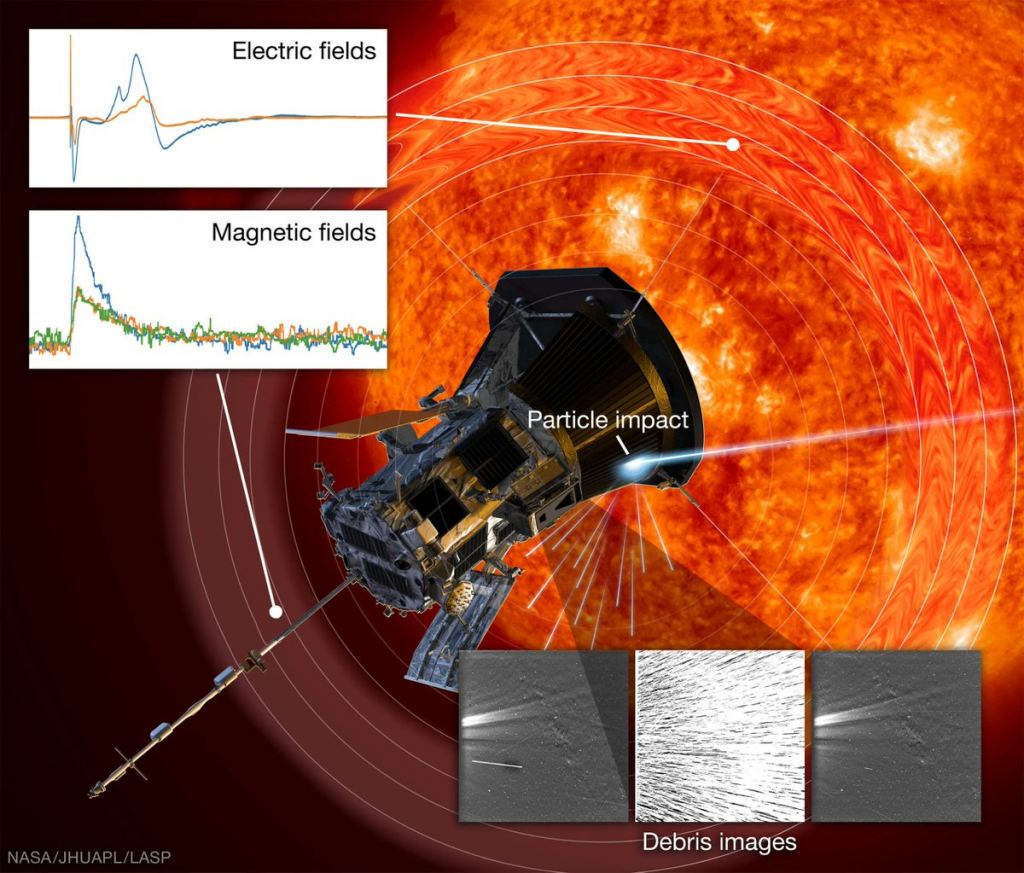By Andy Tomaswick
There’s a pretty significant disadvantage to going really fast – if you get hit with anything, even if it is small, it can hurt. So when the fastest artificial object ever – the Parker Solar Probe – gets hit by grains of dust that are a fraction the size of a human hair, they still do damage. The question is how much damage, and could we potentially learn anything from how exactly that damage happens? According to new research from scientists at the University of Colorado at Boulder (UCB), the answer to the second question is yes, in fact, we can.
Parker is cruising through the inner solar system on its orbit around the Sun at a cool 180 km/s (400,000 mph). But the environment it is traveling through is anything but cool – the probe needs the help of a giant heat shield to ensure that the full force of a star doesn’t entirely destroy its innards. That heat shield isn’t always facing the direction the craft is going through, so it can’t continually protect the sensitive inner body from any dust impacts, some of which can happen at an astonishing 10,800 kph (6,700 mph).
So what happens when that dust impacts the spacecraft? Usually, first, the grains vaporize, then ionize, which separates the ions and electrons that make up the atoms of the grain, resulting in a plasma. These plasmas themselves create a tiny explosion that lasts for only a thousandth of a second. Larger grains, however, can actually create debris. Some of that debris is made of vaporized dust, but some of it might be small parts of Parker itself blasted off by the dust grain.
There’s another consequence of these impacts that are not as visible to the naked eye – they disturb the electromagnetic field around the probe. That disturbance is what Dr. David Malaspin of the Laboratory of Atmospheric and Space Physics at UCB is using to understand even more about Parker’s local environment.
Since it is closer to the Sun than any other artificial object, Parker is constantly bathed in the solar wind – a stream of plasma that emanates from the Sun. Plasma is made up of electrically charged ions and electrons, so it also has an associated magnetic field. Any other introduced plasma, such as that resulting from the dust collisions with Parker, would impact that magnetic field.
Parker has its own suite of magnetically sensitive instruments to allow it to monitor the Sun’s magnetic field. But they are also helpful in detecting how the plasma created by Parker’s collisions with dust is swept up with the solar wind. While that data does help understand some of the environmental conditions of the “zodiacal cloud” – a large dust cloud located near the Sun – they could also be helpful in understanding how small-scale ionization processes anywhere interact with the solar wind. That can be particularly useful in modeling the interaction of Venus or Mars’ atmosphere with the solar wind.
As part of that magnetic study, the researchers also looked at some of the debris that had been kicked off of the probe itself. In some instances, the debris situated itself in less than ideal positions – such as right in front of a navigational camera, causing a streak in the image or sunlight to reflect into it, and briefly disorienting the probe. For a mission like Parker, which must be constantly vigilant about its orientation lest it is fried by the Sun, such disorientation could bring an end to the whole mission.
For now, Parker has a lot more mission to go. Its primary task goes until 2025, with another fifteen orbits around the Sun planned on top of the nine it has already completed since its launch in 2018. Hopefully, it will be able to remain operational for the next four years while still holding onto the title of “most sand-blasted spacecraft” in addition to its other accolades.
Learn More:
UC Boulder – Tiny grains, severe damage: LASP-led research shows how hypervelocity dust impacts can damage a spacecraft and disturb its operations
APS – Rapid plasma bursts and lingering debris clouds driven by hypervelocity dust impacts on Parker Solar Probe: an unintentional active experiment in the inner heliosphere
Space.com – Hypervelocity dust impacts cause plasma explosions on Parker Solar Probe
SciTechDaily – Hypervelocity Dust Impacts on a Spacecraft Produce Plasma Explosions and Debris Clouds
Lead Image:
Artist’s image of Parker with the graphs and images associated with the study.
Credit – NASA / JHUAPL / LASP
The post The Parker Solar Probe is getting pelted by hypervelocity dust. Could they damage spacecraft? appeared first on Universe Today.

November 30, 2021 at 02:52AM
via Universe Today read more...

0 Comments